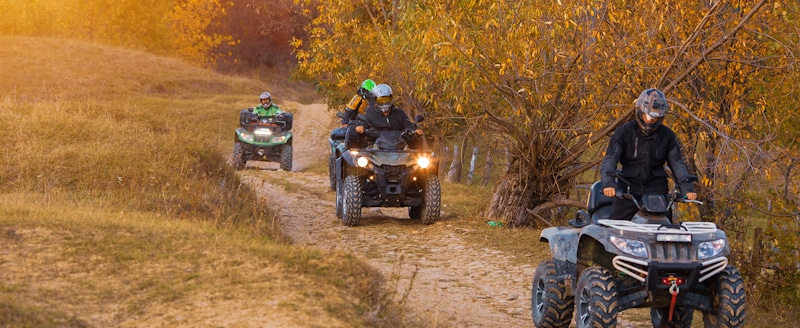The Suzuki LTR 450 is only one of the industry-leading products offered by the Japanese company Suzuki Motor Corporation. The company has a long and fascinating background and did not begin in the automotive industry. Suzuki began as a weaving loom company in 1909 before evolving into the top car manufacturer it is today.
The Suzuki LTR 450, also known as Quadracer LT-R450, is clearly among the most refined performance ATVs of all time. This purpose-built vehicle defeated real sport ATVs throughout the early 2000s thanks to its RM-Z450 450cc engine, sturdy chassis, outstanding suspension, and aggressive design.
The business is well-known worldwide for its extensive line of top-notch cars, internal combustion engines, 4-wheel drive vehicles, wheelchairs, and motorcycles. Suzuki is among the world's top manufacturers of four-wheelers.

How Much Horsepower Does A LTR 450 Have
The Suzuki LTR 450 is quick for a regular rider and weighs only 369 pounds; it has 41 horsepower. This Quad Racer, available from 2006 to 2008, was designed from the beginning to be a professional hotrod. Suzuki engineers and Doug Gust worked together to develop a potent, track-ready quad that was reliable and simple to ride.
The rider could fine-tune the rear and front suspensions to suit their mass and the driving conditions because they were completely adjustable. A lightweight frame was used to keep the center of gravity and engine low. The 450cc engine's race-inspired characteristics included 41 horsepower and fuel injection.
Despite weighing only 368 pounds, the Suzuki LTR 450 is swift enough for most riders. However, on the other hand, the FIPK Performance Air Intake System could increase your quad's performance by roughly 2.7 horsepower and improve its track performance.
A more efficient airflow passage is provided to the engine by the FIPK Performance Intake System, helping it to regain some missing horsepower. In addition, the larger K&N increased air filter and the throttle body are connected directly with a longer, more efficient HDPE inlet tube.
It guarantees that the 450cc piston gets a consistent fresh air supply without making many turns. In addition, a powder-coated sturdy heat barrier is installed in place of the OEM air box to prevent heated engine air from entering the intake system. After a race, you may also quickly wash recyclable gauze air purifiers to achieve optimum ventilation.
How To Change Oil In LTR 450
To change the oil in your Suzuki LTR 450, you will need a drain pan and a set of wrenches. First, you will have to start the engine for about five minutes so that the oil can become warm. Next, put the drain pan directly beneath the engine and unscrew the bolts in the case and oil tank with the wrench.
Let the oil drain for about 10 to 15 minutes; then, screw back the bolts you removed. While screwing them back, be careful not to strip the threads because the oil tank has delicate threads, so you must not overtighten the plug. Now, remove the cover on the oil filter with the wrench.
Put down the cover of the oil filter first, then the spring, and then the filter. Now put the filer inside first, then the spring, and the cover; screw it tightly with the wrench. 400 ml of oil should go into the clutch housing, and 1400 ml should go into the oil tank.
For about five minutes, let the engine run. After turning it off, check the level. The dipstick should not be threaded; instead, put it into the cap's base and remove it to inspect. Add extra oil, if required.
The Suzuki LT-450 uses synthetic oil from AMSOIL. AMSOIL synthetic oil is resistant to heat and the strain of hard riding. Additionally, they increase the Suzuki LT-450's lifecycle by offering top-notch engine maintenance and damage reduction.

Suzuki LTR 450
The LTR 450, a high-performance vehicle designed to succeed on the motocross course, was introduced in 2006. Suzuki's design team began work on the four-wheeler, which would soon serve as the prototype for the next series of sport quads, by enlisting the assistance of racer Doug Gust, who has experience in motorsports.
The result was a tournament beast that was swift and nimble, handled beautifully, and thrived on the excitement and guts of its daring riders. Similar to how champion rider Dustin Wimmer has gained recognition in the ATV Pro MX scene, the 2006 LTR 450 has made an impression since its release in the worlds of GNCC and motocross racing.
Wimmer and the specially designed vehicle have each won back-to-back titles. However, Wimmer was not the only person who helped ATV's reputation. Doug Gust, a racing champion, was essential to the machine's innovation and production.
The QuadRacer differs from other quads in its class in many more ways than just power. Everyone asserts that they provide the typical customer with something unique or distinctive, but this model was the sole factory sport ATV of its period to defy the stereotype.
Despite the absence of a pricey chassis, suspension modifications, or other bolt-on additional items, it was fiercely race-ready. If it did require anything, a kill switch and the nerf bars would be suggested additions; however, these would be more for aesthetic purposes than to improve performance.
From the 2007 Suzuki LTR 450 onward, things only improved as Suzuki was laser-focused on eliminating the 44's faults and magnifying its strengths. On the outside, not much has changed. However, the suspension and engine systems have been altered more than a hundred times.
An RK O-ring chain manages wheel rotation. The quad's power delivery is improved through fuel injection remapping. Swapping to a 12-tooth front sprocket adds a low-end grunt and improves the vehicle's suitability for trails without compromising ground clearance.
Despite industry trends, Suzuki maintained it and avoided replacing it with an aluminum structure. Instead, the brake pedal and rear fender bracing were made of forged aluminum rather than having the chassis modified. The riding posture is extensively designed and is built on Doug Gust's suggestions from the LTR 450's conception in 2006.
The jagged footpegs, conventional T-shaped seating, and handlebars perfectly align, modeling the riding position after that of a professional racer. The bold overall style is offered in White and Champion Yellow.
The auction prices for the LTR 450 range from $1,500 to just over $12,800 based on the manufacturing year and trim. Used cars with many options cost, on average, $4,500. Near-mint units come with heel and frame protection, nerf bars, a custom graphics kit, and Pro taper fat bars, worth at least $7,000.
As if that was not enough, some used LTRs are powder-coated and street-legal. The QuadRacer models from 2007 appear to be the cheapest; these vehicles are available, unlike most sport ATVs. The Suzuki LTR 450 uses a 4-stroke, liquid-cooled DOHC engine.
Top speeds on the Suzuki LTR 450 range from 74 to 78 mph. In its 3rd year of manufacturing, the LTR 450 enhanced its acceleration by 3 mph. This year, Suzuki's LTR 450 outperformed Yamaha's LZ450 by 3 miles per hour, increasing its top speed from 74 to 78 miles per hour.
The front sprocket's performance rating can be increased to 90 mph by adding an open filter box lid. The Suzuki LT-R450 can handle a variety of terrains, including muddy puddles and steep inclines, according to riders who have taken it through its trials.
Final Thoughts
The LTR 450's motivation for production is just as admirable as the car itself. Suzuki wants to increase participation in racing by lowering the cost of owning a track-ready 44 more than just producing a market-leading ATV. However, even unconvinced recreational riders could not resist the machine's enjoyment aspect, ability to tear up trails, and capacity to clear extremely high jumps.
Shawn Manaher loves to play with new toys and dive into new hobbies. As a serial entrepreneur, work definitely comes first but there is always room for hobbies.

![Suzuki LTR 450: [WHAT YOU NEED TO KNOW, IS IT WORTH IT?]](https://hobbynation.net/wp-content/uploads/2022/09/ltr-450-720x405.jpg)